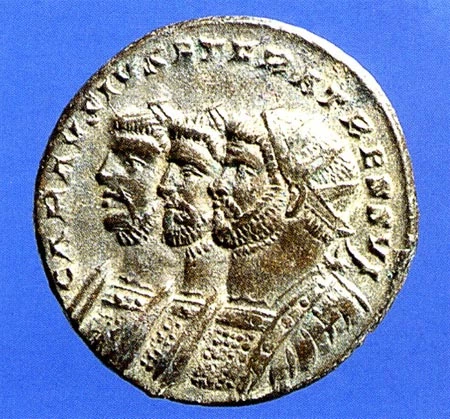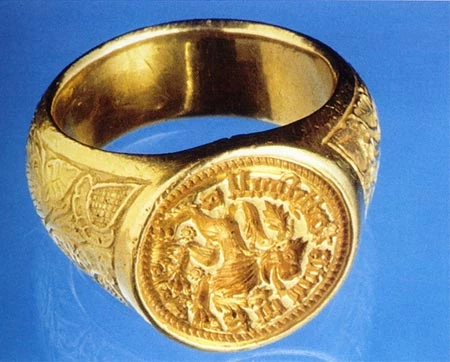Metal detector discoveries from Monmouthshire: Two spectacular treasure finds
In 1998 two separate but significant discoveries were unearthed by metal detectorists in Monmouthshire - a unique hoard of roman coins from Rogiet and a gold ring from Raglan. Both finds were significant and fine examples of treasure that are now in the collections of Amgueddfa Cymru.
The Treasure Act of 1997
The Rogiet hoard, as found.
'Carausius and his brothers' (Rogiet hoard)
The Treasure Act of 1997 covers certain classes of coins and precious metal objects found in England and Wales and has extended legal protection to single objects of gold and silver and to virtually all coin hoards. The new regulations have provided improved protection for certain categories of newly-found antiquities, and better opportunities for preserving these for the public benefit.
Since the act came into force, staff from Amgueddfa Cymru have handled numerous finds, including the spectacular discoveries of an unique hoard of Roman coins from Rogiet and a massive gold signet ring from Raglan.
One of the finest hoards of roman coins ever found in Wales
In September 1998, thousands of Roman coins from the third century AD were discovered by Colin Roberts at Rogiet, Monmouthshire. This was one of the finest hoards ever recorded from Wales and were declared treasure in December 1998.
The 3,750 coins had been buried, possibly in a wooden box, around AD 295-6 (we believe this to be the date since there were no coins later than this in the box) and span a forty-year period, with twenty-two emperors represented, a sign of the political instability of the times.
Political trouble
Their deposit, and the owner's failure to recover them, probably relate to this military and political instability. At the same time, however, the currency of the Roman empire was going through major change. In AD 294-5, new gold, silver and copper alloy coins were introduced to uniform designs and standards empire-wide.
The hoard is made up of an unusual composition for a British find as the coins found in it were not circulated in great numbers here. The hoard is significant as it contains a number of faulty issues of the 260s, and also because it contains over 750 coins of the two individuals who declared themselves Emperor in Britain, Carausius (287-93) and Allectus (293-96). These are not often found in hoards and contain rare denominations representing a variety of warships.
Also included in the hoard is a particularly fine specimen, perhaps the best in existence, of a classic rarity of the Romano-British coinage series. In around 292, Carausius seems to have wanted official appreciation from the emperors Diocletian and Maximian, issuing coinage in their names as well as his own. He even depicted himself with the others on a single design, with the slogan 'Carausius and his brothers'. The feeling was not shared, and within a year Carausius was gone, murdered by his minister Allectus.
An ornate gold ring from Raglan
The Raglan Ring
In the same year as the Roman coins were unearthed at Rogiet, a massive and ornate gold signet ring was found near Raglan, Monmouthshire, by Ron Treadgold, and was also declared treasure. The ring has a circular bezel engraved with a design of a lion on a bed of flowers, within a single cable border with the legend: to yow feythfoull or feythfoull to yow and initials W A either side of the lion.
The finest example of late medieval gold jewellery to be found in Wales
The shoulders of the ring are decorated with flowers and leaves and is significant for the study of late medieval rings as very close comparisons exist in the engraving on the gold episcopal ring of John Stanbury, Bishop of Hereford (1452-1474), a mid 15th century cross from Winteringham, Lincolnshire and a gold ring from Godstow Priory, Oxfordshire. The Raglan ring is likely to date from the middle or third quarter of the 15th century, and is perhaps the finest example of late medieval gold jewellery ever to be found in Wales.
The ring's owner
The original owner of the seal has yet to be identified, though the finding of the ring near Raglan and initials W A make William Herbert, first Earl of Pembroke (executed after the battle of Banbury during the Wars of the Roses, in 1469) a possibility. He married Anne Devereux, and the initials might stand for William and Anne.
The size of the ring suggests that it was worn by a man, and the inscription may be regarded as a sign of faithfulness to his wife. Herbert was one of two men referred to as the 'chosen and faithful' to the new king, Edward IV, and on Edward's coronation he was ennobled. However, the identification of the ring as that of William Herbert is not proven and other names are possible.
At present, all that we can safely say is that the ring was a mark of rank, and probably belonged to an important officer or visitor to Raglan during the second half of the 15th century.



Comments - (2)
Hi there anon,
Thanks for your enquiry. The value of this collection, as with many many others, will be constantly changing according to the markets, sometimes dramatically. We do not hold the expertise to value collections in the museum and rely on external specialists when we require valuations.
Sara
Digital Team